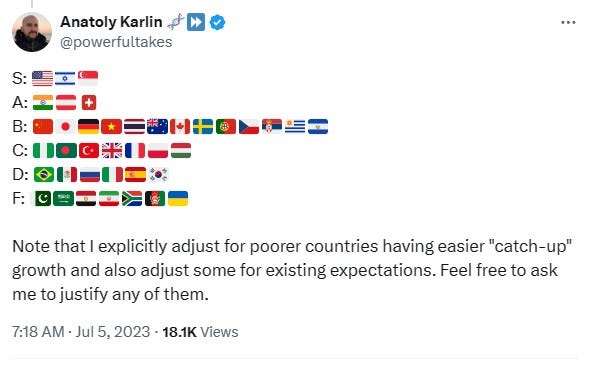The Collapse Of CRE Debt Is Accelerating
by Dave Kranzler, Investment Research Dynamics:

The commentary below is the opening commentary in the latest issue of my short seller’s newsletter. You can learn more about here – also profile Arbor Realty (ABR), which underwrites loans for the worst type of CRE garbage: Short Seller’s Journal information
The graphic above was sourced from @BankerWeimar. Powell once again earlier this month said that “bad commercial real estate loans will likely cause some bank failures but don’t pose a risk to the overall system.” Either he’s blind to reality or lying. Probably the latter. All we need now is for Powell to assure us that CRE loan defaults are “contained” a couple more times to confirm that a collapse is around the corner.
TRUTH LIVES on at https://sgtreport.tv/

The CEO of a big investment fund (Fortress Investment Group) that has been buying CRE loans at prices ranging from 50 cents to 69 cents on the dollar said that about half of the maturing loans in CMBS securities (commercial mortgage back bond trust) are troubled. But it is going to get much worse. The CEO of Cantor Fitzgerald warned recently that there could be as much ast $1 trillion in commercial real estate defaults coming over the next two years. Moody’s estimates that 80% of CMBS office loans are at risk of default or restructuring this year.
Part of the problem is the work from home trend triggered by the covid cluster-you-know-what. But there has been an oversupply of commercial real estate in most metropolitan areas for quite some time (20 years). I’ve seen data thats suggests some of the biggest cities now have an office building vacancy rate of 50% or higher. A local business rag here in Denver said that 38% of the office space in Denver is empty. Two buildings in San Francisco were recently written-down to zero by their owner (which will soon be the bank that is sitting on the mortgages).
Most of the existing CRE debt was underwritten while interest rates were below 2% and asset values were rising. As long as banks were willing to lend the trillions printed by the Fed, there were developers who would put up buildings. With rates much higher now and the value of CRE plummeting, it will be nearly impossible to refinance most of what needs to be refinanced over the next two years. The majority of buildings requiring refinancing are worth far less than the amount of debt outstanding. As an example, earlier this month an office tower in Chicago’s River North area went under contract at a price that was just 33% of the seller’s outstanding loan. An office tower in Baltimore that is 51% vacant is being auctioned at a starting bid of $4 million. And an office tower in Manhattan sold this month for $150mm. It was purchased in 2014 for $500mm.
Another big problem is there has yet to be consistent price discovery for the value of office buildings other than the fact that the value of office buildings continues to decline when there is a distressed sale. The Wall Street Journal published an article last week titled “America’s Office Fire Sale Has Barely Begun:”
Only 3.5% of offices sold last year came from a distressed seller, thanks to optimism and forgiving lenders…forced sales are still surprisingly rare. In 2023, only 3.5% of all office deals in the U.S. involved a distressed seller, based on analysis by MSCI Real Assets. Pressure is building slowly as leases expire: Many companies are reducing their space by 30% to 40% when their contracts end. Lenders are also eager to kick the can down the road. They don’t want to force borrowers to sell buildings into a weak commercial real-estate market, which would lead to punishing losses.
Per the report, as I suspected banks are giving distressed borrower loan extensions to avoid foreclosure and a distressed sale. The benefit of this is that the bank does not have to take a big impairment charge and a large write-off of the loan. But, unless there’s a miraculous U-turn in CRE akin to Moses parting the Red Sea, kicking the can down the road will make the problem even worse, particularly with the economy heading south.
Then there’s the issue of OTC derivatives. Despite the fact that CRE loans represent a small percentage of the loan portfolios at the biggest Wall Street banks, analysts and financial media reporters are overlooking the massive exposure of these banks to CRE via OTC derivatives. Massive. Much of that exposure is accounted for off-balance sheet (opaque data tables buried in the footnotes to the financial statements). This is thanks to accounting “reforms” in 2010 that enabled the big banks to move most of their risk exposure to OTC derivatives off-balance sheet. And the counterparty risk is enormous.
The distressed mortgages were a big problem during the great financial crisis but it was the bank banks’ exposure to the bad loans via OTC derivatives that pushed the banking system to the brink of collapse and triggered trillions in money printing. Goldman Sachs, which was exposed to AIG’s subprime mortgage holdings via credit default swaps, would have collapsed in 2008 if Henry Paulson had not convinced Obama and Congress to bail out the big banks. As well, Citigroup and Morgan Stanley likely would have disappeared.
Bloomberg published a report on March 19th which discussed rapidly rising impairment of CRE CLOs (collateralized loan obligations), which are used to finance risky commercial real estate projects – projects a bank won’t touch. The ongoing and accelerating melt-down in these CRE CLO’s is the basis for shorting Arbor Realty Trust (ABR), which I mentioned in the last issue and which is profiled below.
Read More @ InvestmentResearchDynamics.com



